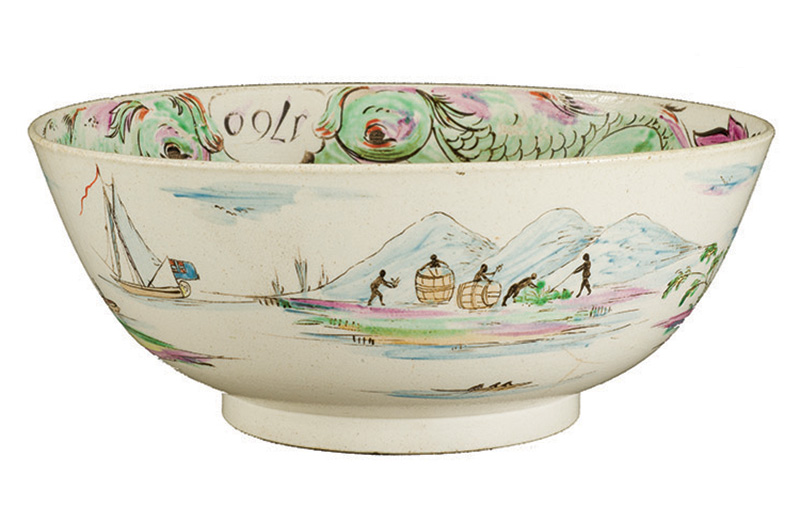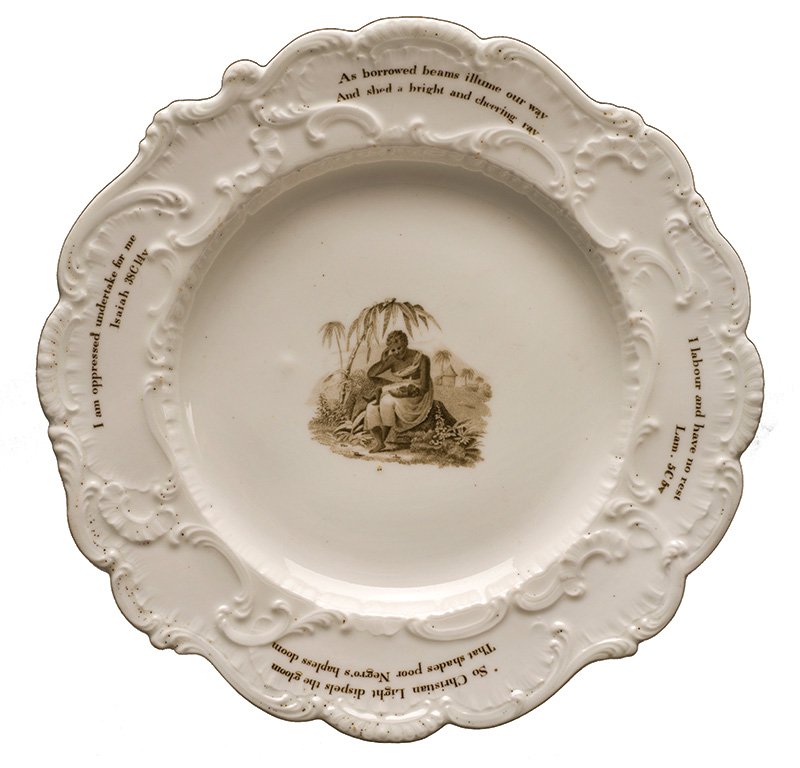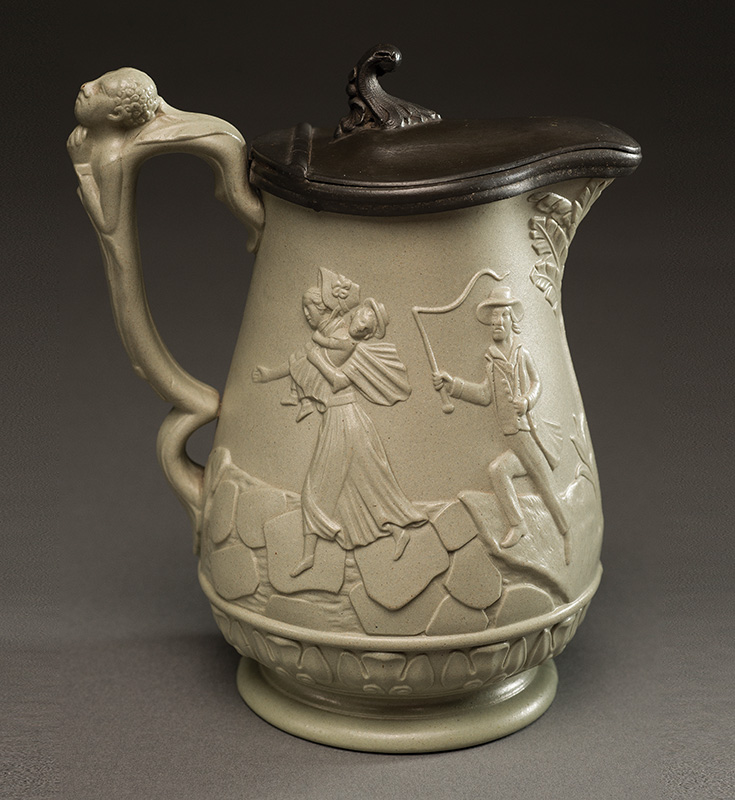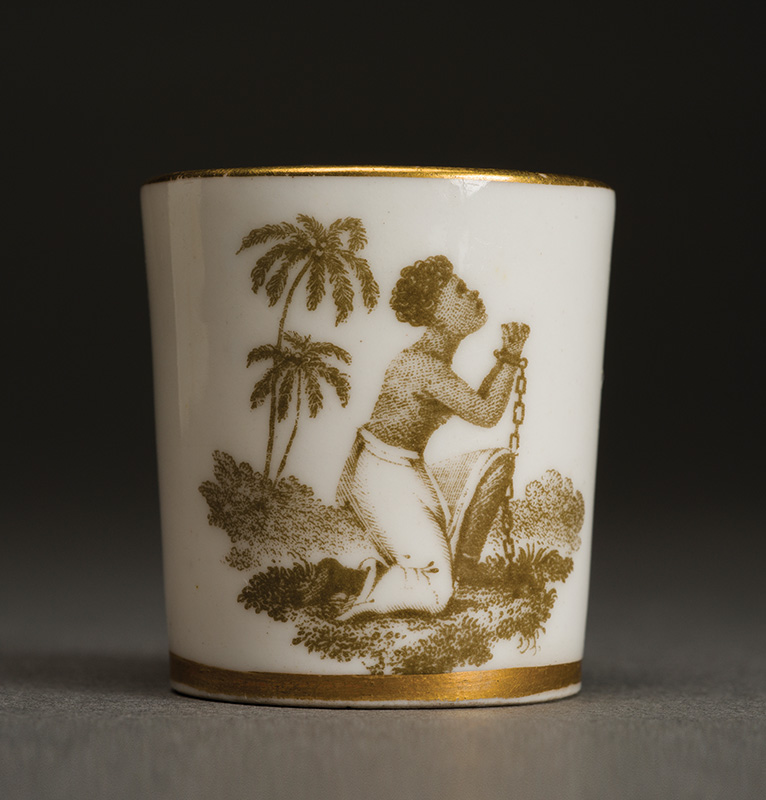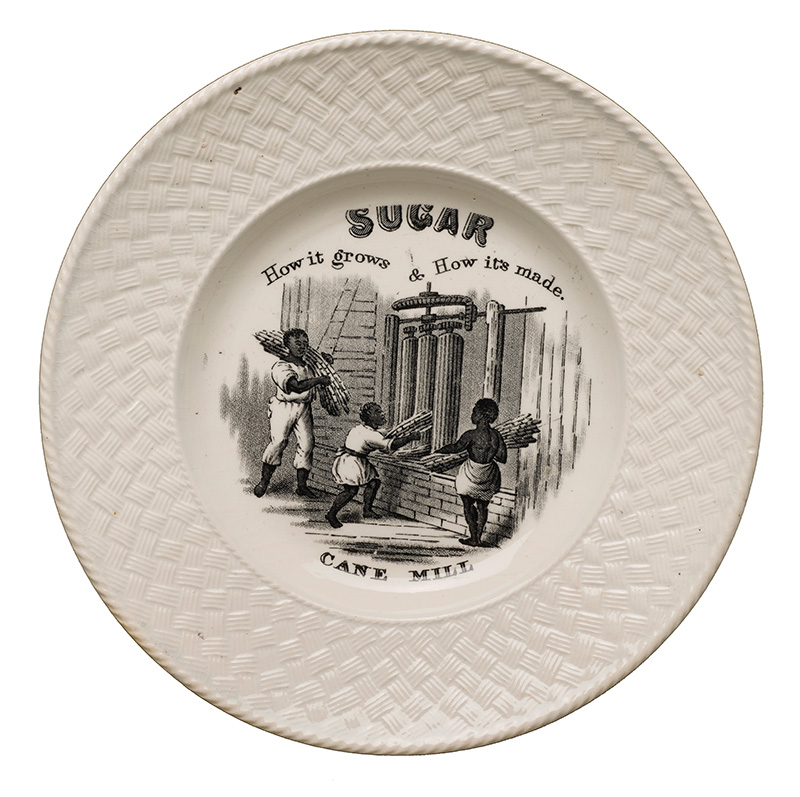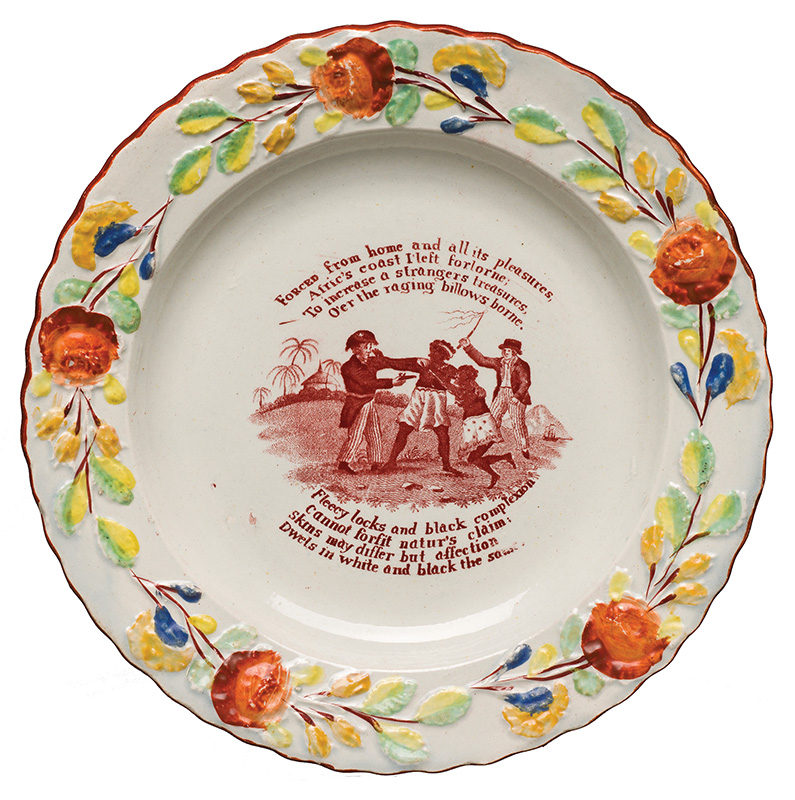Anti-Slavery Ceramics at Historic Deerfield
by Daniel Sousa
In 18th- and 19th-century Britain, locally produced ceramics became an important medium for celebrating the economic benefits of slavery as well as denouncing its horrors. Port cities such as Liverpool reaped great wealth throughout the 18th century as a result of the slave trade. Ship captains and local businesses profited immensely from the trade, and consumers actively purchased materials, such as sugar, tobacco, and cotton, acquired during these voyages. By the late 18th century, however, critics of slavery grew louder. Founded in 1787, the Society for the Abolition of the Slave Trade in England began a movement that led to the prohibition of the international trade in 1807. This milestone was followed by a second in 1834 when the practice of slavery was abolished (with some exceptions) throughout the British Empire. These changing attitudes towards slavery are poignantly reflected in a group of British ceramics at Historic Deerfield, many of which are recent additions to the collection.1
A rare white salt-glazed stoneware punch bowl commemorates the 1760 voyage of the Liverpool slave ship the Friendship, including scenes of various stopping points along the ship’s route. Turreted structures painted on the sides of the bowl possibly depict slave castles on Africa’s west coast—fortresses constructed by the British and Dutch for holding captured men and women before shipment overseas. A rare depiction of several black figures painted on the side of the bowl also appears to depict enslaved persons harvesting tobacco in the West Indies (figure 1). A third scene painted on the side of the bowl of a gentleman presenting a seated lady with a pouch, is possibly a rendition of the popular 18th-century print, “The Sailor’s Return”—a celebratory scene in which a sailor presents his lover with a purse full of riches earned from a successful voyage. This imagery, combined with the bowl’s inscription, “Success to the Frendship [sic],” highlights the routine nature of the trade in the 18th century and the profitability such a voyage afforded the ship’s captain and investors.2
By the early 19th century, imagery on British ceramics related to slavery and the slave trade had changed drastically. Rather than celebrating the profits earned from the trade, designs forthrightly expressed a condemnation of slavery. Historic Deerfield has acquired the examples discussed here over the past two years in order to address this seminal topic. A luster-decorated jug with a scene of a seated enslaved man partly bound in chains (figure 2) is accompanied by the phrase, “Am not I a Man and a Brother”—a design inspired by a jasperware medallion produced by Josiah Wedgwood (1730-1795) in 1787 (see p. 25). This scene, along with a lengthy verse from William Cowper’s (1731-1800) poem “The Negro’s Complaint” (1788) printed on the reverse, highlights the plight of enslaved persons while appealing to a sense of common humanity. The jug’s small size suggests it was used as a display piece in the home and was likely purchased at an anti-slavery fair where similar ceramics were available for purchase.
In addition to poetry, religious sentiments were employed to denounce the practice of slavery. A porcelain plate featuring a scene of a seated enslaved woman cradling a sick child in her arms (figure 3) includes two verses from the Old Testament: “I am oppressed undertake for me [Isaiah 38:14]” and “I labour and have no rest [Lamentations 5:5].” The image, taken from the “Third Report of the Female Society for Birmingham, West Bromwich, Wednesbury, Walsall, and their Respective Neighbourhoods, for the Relief of British Negro Slaves” (1828), elicits sympathy by depicting the enslaved woman as a caring, maternal figure.
Oftentimes, abolitionist fervor was spurred on by popular literature of the day. Harriet Beecher Stowe’s (1811–1896) anti-slavery novel Uncle Tom’s Cabin (1852) received wide acclaim after its publication, which encouraged entrepreneurial potters to include scenes from the novel on their ceramics. A green stoneware jug features relief molded decoration of two scenes from Beecher’s novel: a slave auction and the escape of the enslaved woman Eliza across the Ohio River (figure 4).
The survival of a number of anti-slavery ceramics for children may reveal abolitionists’ hope and intent to educate a younger generation of activists. Miniature cups, including one with a scene of a kneeling, supplicant slave, may have been part of a child’s tea set (figure 5). While the size of these objects suggest their use among children, it is possible that potteries produced them for a wider age range.
These children’s ceramics may have also functioned to educate the young about the hardships of slavery. One plate, for instance, was possibly produced to illustrate the hard labor and hazards to which enslaved persons were exposed when producing sugar (figure 6). At the center of the scene, an enslaved child inserts stalks of sugar cane into a three-roller grinding mill with his hands precariously close to the rollers, which included sharp blades to shred the cane.
Other examples were more explicit in exposing the harsh realities of the slave experience. One plate illustrates the very first step in the process of enslavement: the capture of Africans in their native homeland before shipment overseas (figure 7). In this scene, two Africans are detained by two men brandishing a pistol and a whip. Verses from Cowper’s “The Negro’s Complaint” encircle the scene. The bright colors and relief molded floral decoration on the rim of the plate stand in stark contrast to the plate’s cruel scene.
As material documents of changing social and cultural attitudes towards slavery in the 18th- and 19th-century Anglo-American world, these items hold an important place in Historic Deerfield’s ceramics collection. Their inclusion will help to educate current and future generations about the question of slavery and the experiences of enslaved persons in 18th- and 19th-century America.
1 For more detailed studies of anti-slavery ceramics, see Sam Margolin, “‘And Freedom to the Slave’: Anti-Slavery Ceramics, 1787-1865,” Ceramics in America (2002): 80-109, and Mary Guyatt, “The Wedgwood Slave Medallion: Values in Eighteenth-Century Design,” Journal of Design History 13, no. 2 (2000): 93-105.
2 For a more complete study of the Friendship punch bowl, see Daniel S. Sousa, “History in Stoneware: Depictions of the British Slave Trade on an Eighteenth-Century English Punch Bowl,” Historic Deerfield, Autumn 2018, 36-40. For a detailed study of ceramic punch bowls commemorating English slave voyages, see Jane Webster, “‘Success to the Dobson’: Commemorative Artefacts Depicting 18th-century British Slave Ships,” Post-Medieval Archaeology 49, no. 1 (2015): 72-98.
Daniel Sousa is Assistant Curator at Historic Deerfield.
A print version of this article was published in The Magazine of the Decorative Arts Trust, one of our most popular member benefits. Join today!

